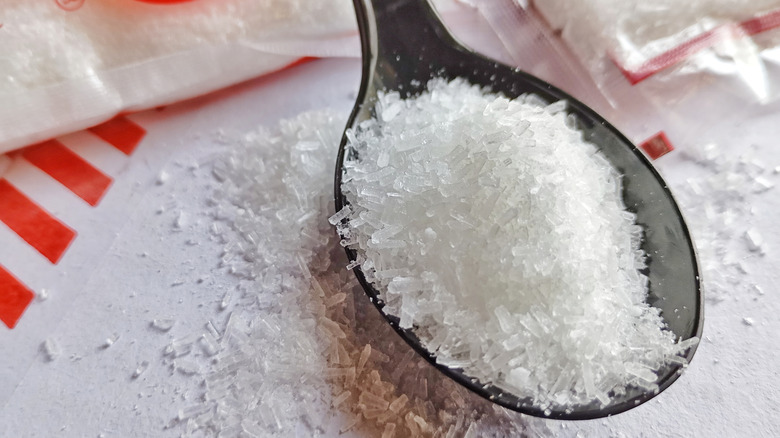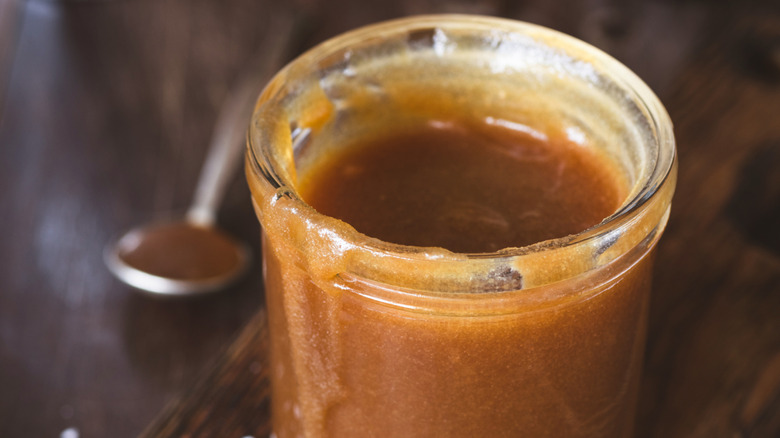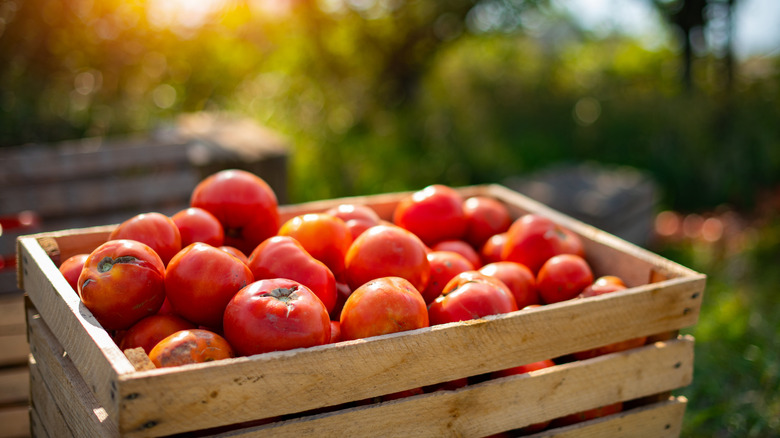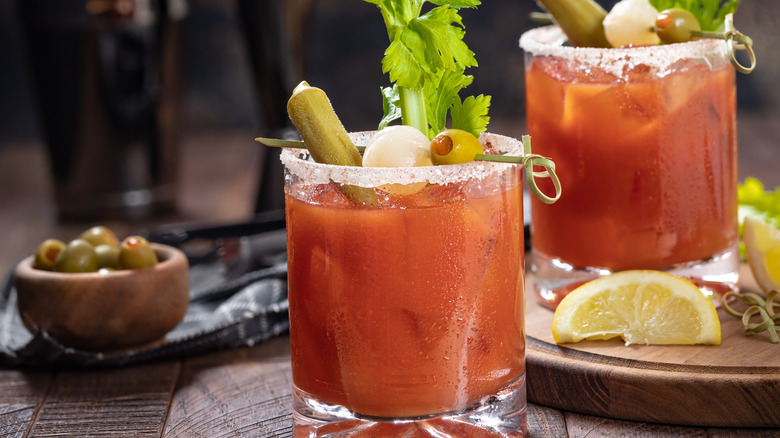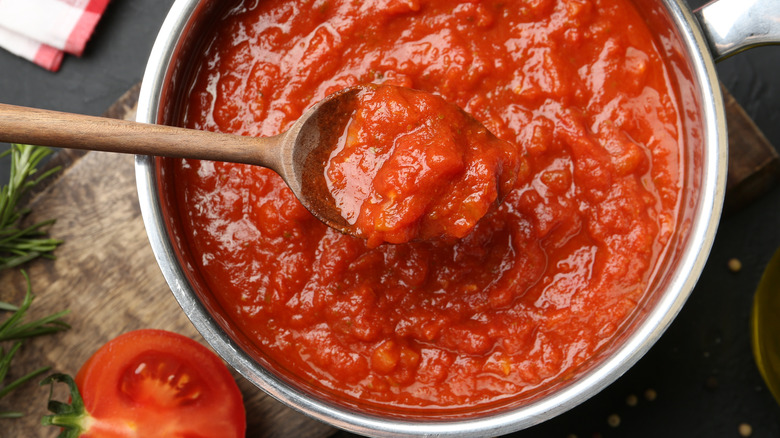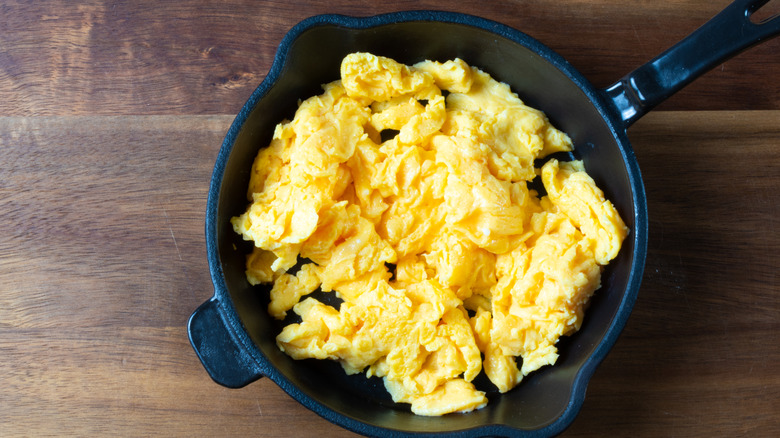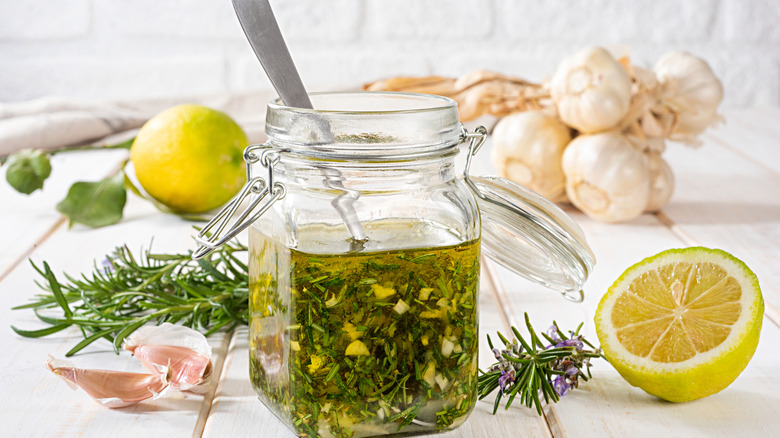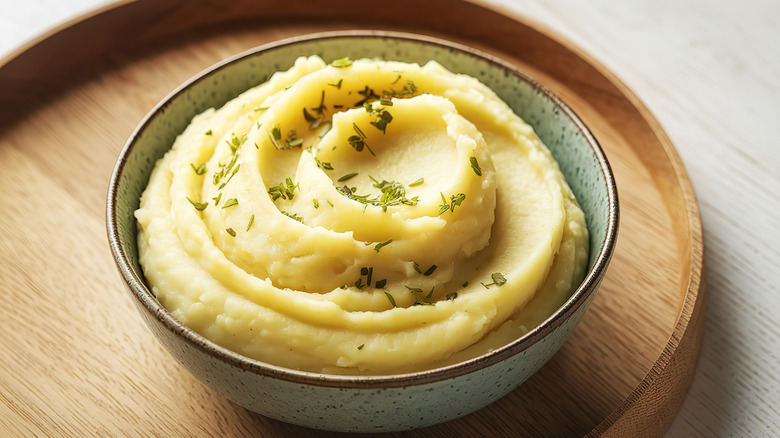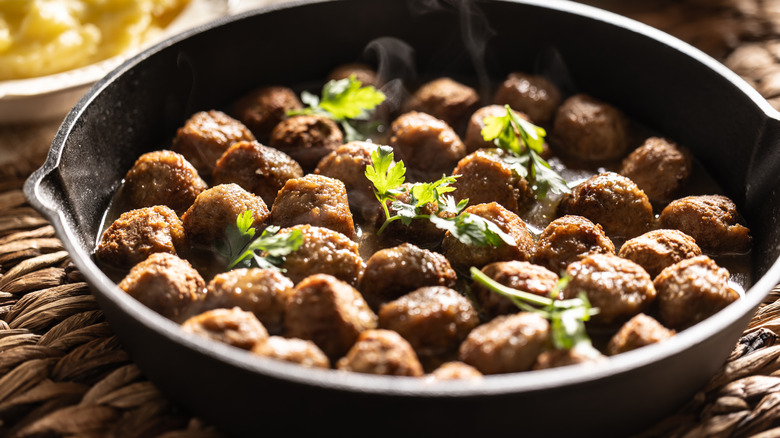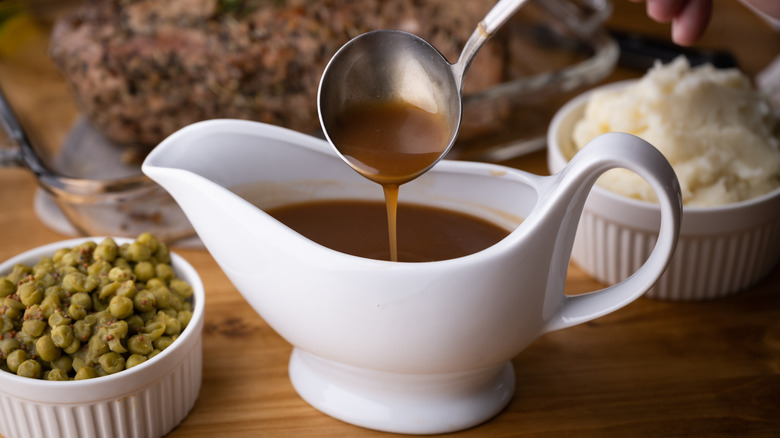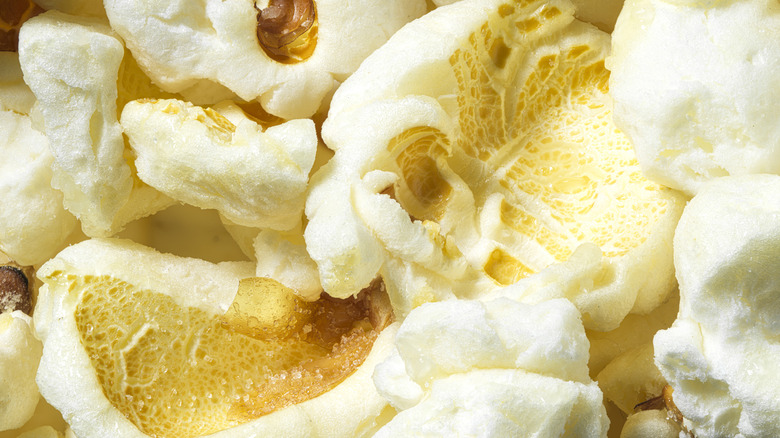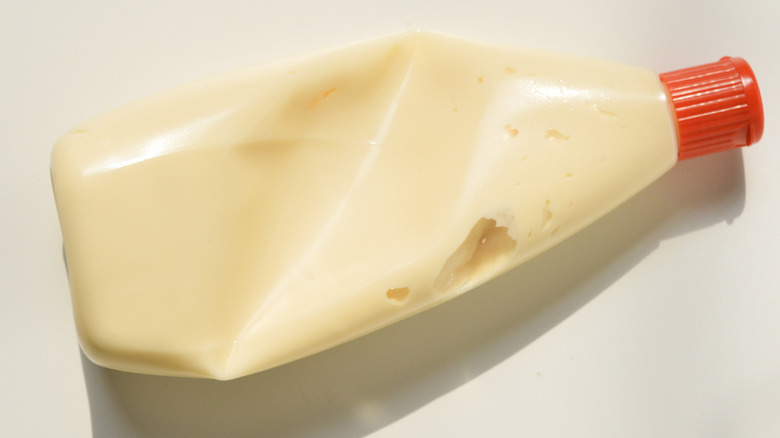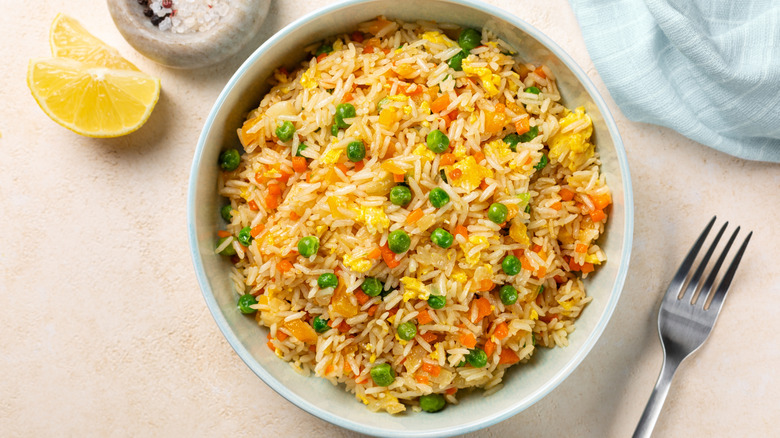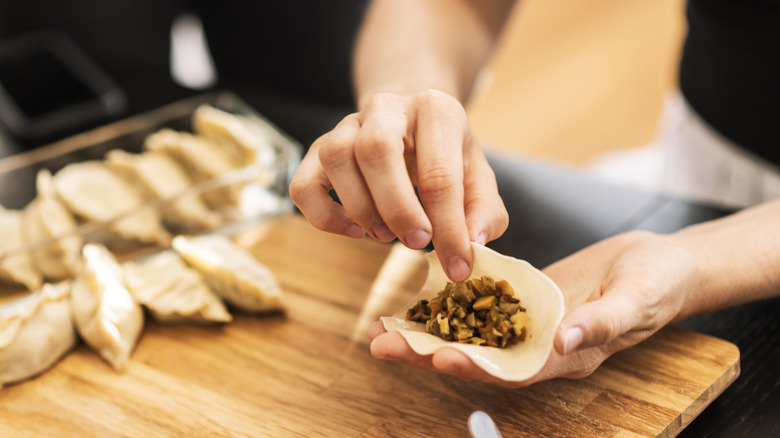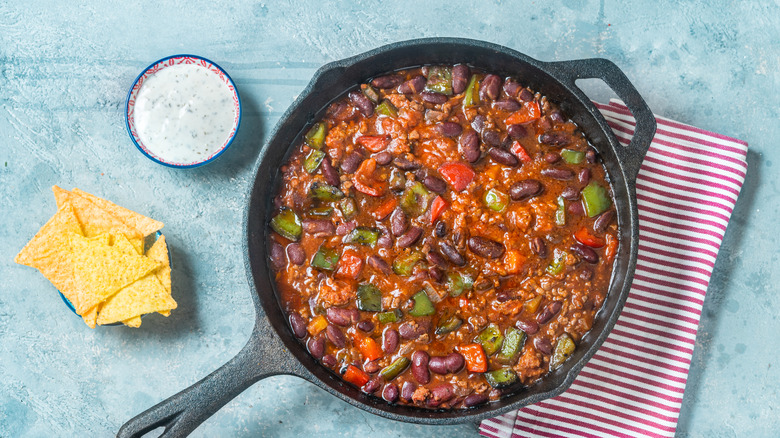16 Foods That Benefit From A Dash Of MSG
If we were giving out awards for the most vilified foods ever made, monosodium glutamate (MSG) would certainly be at the top of the list. This crystalline powder is a food additive that increases umami — a flavor that's often defined as being "savory" or "meaty." The glutamate ("G" in MSG) naturally appears in a range of foods, including tomatoes, mushrooms, processed meats, and nuts. So, when you add MSG to a food, you are essentially turning up the umami dial and, in turn, honing the four other flavors: bitter, sweet, salty, and sour.
Despite the controversy over the years, MSG is "generally recognized as safe" (GRAS) by the Food and Drug Administration (FDA), and research has debunked the longstanding myth of "Chinese restaurant syndrome," firmly establishing that MSG is safe for consumption (via National Library of Medicine).
If you didn't grow up cooking Asian food, or just have zero familiarity with how to work with this ingredient, you're in luck. We've come up with some of the tastiest ways to use this magic, concentrated umami dust to flavor a range of foods.
Caramel sauce
You've heard of salted caramel, but have you heard of MSG caramel? While it may not roll off the tongue as easily, we can assure you that it also tastes pretty great. When the MSG is added to caramel sauce, it can amplify those savory notes and help balance its overwhelming sweetness.
You'll only need to use about a teaspoon of MSG for your sauce, as you don't want to shift the balance too much towards the savory side of things and abandon the sweetness entirely. You can also use MSG in tandem with salt, stirring the two seasonings in with the sugar and the rest of your caramel ingredients.
This upgraded caramel sauce can be used for a ton of different things, be it ice cream, brownies, cookies, or cheesecake. The MSG will add a whole new layer of flavor, depth, and complexity, and it's relatively easy to try at home.
Bland tomatoes
We've all gotten a handful of tomatoes in the off-season only to realize that their flavor is nothing like the ones you get from the farmers' market in the summer. Luckily, MSG is the secret ingredient that can upgrade the flavor of bland tomatoes, and you can use it in whatever fresh tomato dishes you're working with. Tomatoes contain a ton of naturally-occurring glutamate, so when you dose them with MSG, you are making that flavor all the more prominent.
If you're whipping up a summery Caprese salad or jammy tomato toast, for example, all you need to do is stir in just a pinch of MSG along with your usual seasonings, like fresh herbs, salt, and pepper. While MSG won't help you replicate the same juiciness as a fresh-from-the-vine tomato, it can help round out any astringent flavors at play and make your fruit taste a little more balanced.
Steak
Any well-trained chef will tell you that using the proper seasoning is an important step for making steak taste great. The protein itself is already rife with glutamic acid, which it releases as it cooks. When you add a pinch of MSG to your steak seasoning, you can help bring out those meaty undertones even more. You'll want to add this umami flavor bomb to your steak while it's cooking, or use it to enhance the pan sauce that you're serving it with. You may only need about a ½ teaspoon per pound of steak — any more could overwhelm the flavor of your recipe.
You may also be able to cut back on the amount of salt that you're using if you're opting to season your cut with MSG. While MSG doesn't necessarily make something taste more salty — since it primarily targets umami rather than saltiness — it can hone the other flavors in your seasoning more, thus making the salty flavors more prominent. MSG can also be used in tandem with other seasonings and herbs, including thyme, rosemary, and garlic, to enhance the protein's overall flavor profile.
Cocktails
This one might sound a little bit out of left field, but trust us a little bit. MSG is the secret ingredient for more flavorful cocktails — you just have to be tactful and mindful about how you use it.
An easy cocktail that might come to mind when you think about MSG is a bloody mary. This drink has a tomato base, as well as creative umami-rich ingredients such as Worcestershire sauce, anchovies, and the like. When you add a pinch of MSG to the mixture, you'll find that those umami and savory notes are accentuated even more. You don't need to add a ton of crystals to reap this benefit, either; you may only need a single teaspoon for an entire gallon of bloody mary mix.
Another place where this unique ingredient could work is in olive brine, which could be poured into a martini. The olives already have a strong, savory flavor, and adding a pinch of MSG can really amplify those notes and draw them out even more. When using it in a cocktail, you'll ideally want to mix the MSG up with water to make a 2-to-1 water-to-MSG solution before adding it to your drink in small doses. This approach will ensure that the flavor disperses evenly into the brine, and by proxy, the cocktail you use it in.
Tomato sauce
Classic marinara and pizza sauces are made with tomatoes, so it's easy to see how adding a pinch of MSG to the equation can yield a more savory and delicious batch of either. A dash of MSG can be added to both store-bought marinara or homemade sauce; you may just want to taste it first before you decide how much to add.
Not only do the crystals lend a helping hand to canned or fresh tomatoes, but they can also help out another ingredient commonly added to the sauce itself, or foods that you'd cover in the sauce: Parmesan. The cheese is rich in glutamate, and when you add a little bit of MSG to the sauce, you'll find that it amplifies that decadent cheesy flavor even more. Mushrooms and beef are also very high in glutamate, so it may be advantageous to add MSG to a mixed veggie, mushroom-based, or ragù sauce, too.
That being said, you can also use MSG to elevate other, non-tomato-based sauces. For one, you could also use it for a fresh pesto or cheesy sauce that already includes Parmesan, like cacio e pepe or Alfredo sauce. However, you may want to dial back the salt to prevent overwhelming the sauce's flavor.
Scrambled eggs
You may be familiar with some of the many ways to season scrambled eggs, like with herbs, salt, and pepper. But, how about MSG? Just as soy sauce brings an umami flavor to eggs, MSG will step in and upgrade the overall savoriness of the dish — without that strong soy flavor and extra water content.
A good way to add MSG to your eggs is to first make a seasoning mixture with two parts salt to one part MSG. You may only need to add a ¼ teaspoon of this seasoning (not the MSG mixture alone) to half a dozen eggs to give them a greater umami depth. Mix the DIY seasoning together with any other herbs and black pepper before stirring in the eggs and cooking the mixture. Since MSG doesn't really work as a savory sprinkle in the same way that salt does, you'll want to always combine it with some sort of liquid, be it the egg mixture itself or the oil or butter you're cooking the eggs in, to better distribute its flavor.
Salad dressing
Salad dressing is no stranger to MSG, as some popular brands already use it as an additive. The next time you're whipping up a batch of homemade dressing, you may want to consider adding a pinch of MSG to it to give it a store-bought flavor (in a good way).
The great news is that there are very few salad dressings, creamy or vinaigrette-style, that don't work well with MSG. Caesar is one place to start. Not only is it often made with umami-rich cheeses, like Parmesan, but it can also be made with two of the most well-known umami-bomb ingredients: Worcestershire sauce and anchovy paste. These fishy ingredients are very high in glutamate, and their flavor will be made more prominent with the addition of MSG. The seasoning will also cut through the richness of your dressing, which is especially useful for ones made with cream and mayo.
MSG may also be a great ingredient to use if you're trying to cut back on the extra salt you'd normally add to your salad dressing. In a dressing specifically, you can substitute MSG for salt using a 1-to-1 ratio — with the upper limit being at around 1 teaspoon. Since MSG can be very potent, we recommend always tasting your dressing before adding more.
Mashed potatoes
Mashed potatoes are a must-have for Thanksgiving dinner, casual weeknight meals, and everything in between, but they can be a little boring. As it turns out, adding a little bit of MSG to your mashed potatoes can improve their flavor drastically.
Potatoes themselves pack a ton of naturally-occurring glutamate – not bad for a food commonly deemed as "bland." And, not only will adding MSG make their flavor more savory, but it will also heighten the profiles of any ingredients you add to your mashed potatoes, like butter, cheese, chives, or garlic. You'll want to start with about a ½ teaspoon of MSG per pound of potatoes. Since MSG already contains some sodium, you may not need to add as much extra salt to your mashed potato recipe. Or, you may want to opt for unsalted butter instead of the regular stuff to keep the salty flavor in check.
Meatballs
It may seem like every culture around the world has their own variation of meatballs — be it classic Italian ones jam-packed with herbs and Parmesan, or Swedish meatballs served with gravy and lingonberry sauce. But the one thing that they all have in common? They can all be improved with a little sprinkle of MSG.
MSG will latch on to the naturally-occurring glutamates in the meat, thus amplifying its savoriness. While you may be able to taste it more in "meatier" proteins, like beef or pork, it could also be used to bolster the flavors of poultry-based meatballs, including ones made with ground chicken or turkey. You can even add MSG to a plant-based meatball, like those made with umami-rich mushrooms and walnuts — to give them a meatier flavor. You won't need to add more than about a teaspoon per pound of meat, though we recommend starting with about a ½ teaspoon and going from there.
Gravy
Gravy is a fantastic way to make use of those pan drippings and enhance the flavor of other foods on your plate, like biscuits or mashed potatoes. However, you can't just toss some thickener into those drippings and call it a day. If you want a truly flavorful gravy, you're going to have to put some work into seasoning it.
Luckily, MSG is a simple ingredient that can improve the flavor of many different types of gravies, including both beef and poultry-based ones. Add a little pinch to your gravy after the majority of the cooking process is complete, and give it a stir before tasting and adding more as needed. Starting with a ½ teaspoon of the crystals is a good idea, as the flavor of gravy already tends to be very powerful because it's often mixed with hearty, stock, wine, and aromatics. Adding small amounts at a time also ensures you can control the gravy's saltiness.
Popcorn
The best toppings for popcorn are arguably salt and butter, but it turns out there's another seasoning that gives salt a run for its money: MSG. MSG offers just enough saltiness to fill in the gaps, while also giving the popcorn a savory and tasty undercurrent. As with other applications, MSG works best here when it's distributed into a liquid, rather than sprinkled on the popped kernels themselves. Add no more than a ¼ or ½ teaspoon to your melted butter before drizzling it on your fresh kernels.
It's important to note that the amount of MSG you use is dependent on how much popcorn you're making. It's better to start with little less than having to toss your popcorn in the trash because you added too much. While MSG is a great way to elevate plain popcorn, it can also give an edge to a flavored variety as well. For one, you can try adding umami-rich nutritional yeast to your popcorn to give it a cheesy undercurrent; the MSG will heighten its savory, rich flavor even more.
Burgers
Getting the right seasoning for your burger is harder than it looks. While salt and pepper are a given, the next time you're cranking out patties, you may want to consider mixing your protein of choice with a little bit of MSG. The seasoning will help make your burgers extra flavorful and savory.
You may not need to use more than a ½ teaspoon of MSG for each pound of meat. This hack not only works for classic beef burgers, but it can also be applied to turkey, chicken, or even black bean and veggie burgers. The MSG will both play off of the umami flavor in the patty and the flavors in your burger toppings. Mushrooms and onions, for example, are great pairings for an MSG-seasoned burger because the seasoning will draw your attention to the natural sweet and savory flavors at play. You can also whip up a burger sauce with MSG, which will bring out the umami and salty notes of its respective components.
Mayonnaise
You may have never thought to make mayonnaise yourself. But, its actually a pretty easy condiment to whip up in a food processor, provided that you can — and have enough patience to — emulsify the eggs and the oil properly. MSG is a great seasoning for your homemade mayo. When you add MSG to your regular mayo recipe, it will turn into something more adjacent to Kewpie mayo — the famed Japanese condiment known for its eggy flavor. Combine no more than a ½ teaspoon of MSG with other seasonings, like salt, to flavor it.
MSG mayo can be used anywhere you'd use regular mayo. It makes an extra flavorful burger sauce, as the MSG will amplify the meaty notes in your patty, or it can be used as a more flavorful substitute for store-bought mayo in chicken salad. It would also make a great dip for french fries or onion rings, seeing how the savoriness cuts through the greasy richness of these fried favorites.
Fried rice
It may seem like a little bit of a no-brainer to add a popular Asian condiment to an Asian-inspired dish, but MSG truly is the secret ingredient that you need to get restaurant-worthy fried rice at home. Add no more than a ¼ teaspoon of MSG per cup of rice in your recipe. You'll want to add it to the pan after you add the rice. Once you give it a stir, you can season it with other items, like pepper and one of our personal favorite ingredients, mirin, which will help make your fried rice unforgettable by balancing its savoriness with a tinge of sweetness.
MSG is a great addition to fried rice because it boosts the umami flavor of some of its components, like the eggs. It also adds cohesion to some of the flavor profiles, including that of the sweet mirin, aromatics, and meaty proteins like chicken or shrimp.
Dumplings
Making homemade dumplings is a labor of love. Once you get the mechanics down for making a filling and tucking it neatly and effectively into its little wrapper, you can start to explore bolder and more unique flavor additions. This includes MSG, which can be added in small doses to the filling, dipping sauce, or both.
The MSG will amplify the notes of the protein, like pork or chicken, as well as any umami-rich ingredients in it, like soy sauce, fish sauce, or mushrooms. You can use it in tandem with or as a replacement for salt. Though, since most dipping sauces tend to use high-sodium ingredients, like soy sauce or tamari, you may want to avoid over-salting the dumpling filling itself. You don't need to add a whole lot of MSG to make an impact, either; just a ¼ to ½ teaspoon per batch of filling should suffice. Stir it in towards the end of the cooking process so that you can taste and add more as needed. The dipping sauce itself might only need a ¼ teaspoon or less of MSG, since its flavor is likely already highly concentrated.
Chili
Chili is a must-have during the cold winter months, and it's easy to see why. It's filled with filling beans, meat, and aromatics, and is often accompanied by a tomato-forward sauce, making it a warm and comforting dish. All of these components could benefit from a dash of MSG to amp up their flavor.
MSG can help make an already hearty chili even heartier. It can also help draw attention to other aromatic and flavor components, be it sweetness from a dash of cinnamon, smokiness from ancho chili powder, or brightness from a generous splash of lime juice or vinegar. Like some of the other uses for MSG on this list, you don't want to be too heavy-handed with the crystals; about ⅛ to ¼ of a teaspoon of MSG per pot of chili should help round out the flavors of your favorite recipe and make it all the more tasty.
